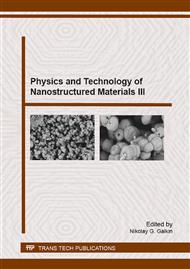[1]
V. Schmidt, J.V. Wittemann, S. Senz, and U. Go¨sele, Silicon Nanowires: A Review on Aspects of their Growth and their Electrical Properties, Advanced Materials, 21 (2009) 2681–2702.
DOI: 10.1002/adma.200803754
Google Scholar
[2]
M.V. Wolkin, J. Jorne, P.M. Fauchet, Electronic States and Luminescence in Porous Silicon Quantum Dots: The Role of Oxygen, Physical Review Letters, 82 (1999) 197-200.
DOI: 10.1103/physrevlett.82.197
Google Scholar
[3]
J. S. Biteen, N. S. Lewis, and H. A. Atwater, Spectral tuning of plasmon-enhanced silicon quantum dot luminescence, Applied Physics Letters, 88 (2006) 131109 (3).
DOI: 10.1063/1.2191411
Google Scholar
[4]
V. V. Uglov *, V. M. Anishchik1 , V. V. Astashynski, Formation of Submicron Cylindrical Structures at Silicon Surface Exposed to a Compression Plasma Flow, JETP Letters, 74 (2001) 213-215.
DOI: 10.1134/1.1413553
Google Scholar
[5]
A. G. Cullis, L.T. Canham, Visible light emission due to quantum size effects on highly porous crystalline silicon, Nature 353 (1991) 335-338.
DOI: 10.1038/353335a0
Google Scholar
[6]
M. Guendouz, P. Joubert , M. Sarret, Effect of crystallographic directions on porous silicon formation on patterned substrates, Mater Sci Eng: B 69 (2000) 43–47.
DOI: 10.1016/s0921-5107(99)00263-9
Google Scholar
[7]
F. A. Harraz, S.E. Sheikh, T. Sakka, Y.H. Ogata, Cylindrical pore arrays in silicon withintermediate nano-sizes: a template for nanofabrication and multilayer applications, Electrochim Acta, 53 (2008) 6444–6451.
DOI: 10.1016/j.electacta.2008.04.045
Google Scholar
[8]
M. Christophersen, J. Carstensen, H. Föll, Crystal orientation dependence of macroporeformation in p-type silicon using organic electrolytes, Phys Status Solidi A, 182 (2000) 103–107.
DOI: 10.1002/1521-396x(200011)182:1<103::aid-pssa103>3.0.co;2-n
Google Scholar
[9]
M. Christophersen, J. Carstensen, Feuerhake A, H. Föll, Crystal orientation and electrolyte dependence for macropore nucleation and stable growth on p-type Si, Mat. Sci. Eng.: B, 69 (2000) 194–198.
DOI: 10.1016/s0921-5107(99)00262-7
Google Scholar
[10]
V.V. Uglov , V.M. Anishchik , V.V. Astashynski , V.M. Astashynski , S.I. Ananin , V.V. Askerko , E.A. Kostyukevich , A.M. Kuz'mitski , N.T. Kvasov , A.L. Danilyuk, The effect of dense compression plasma flow on silicon surface morphology, Surface and Coatings Technology, 158 – 159, 2002, 273–276.
DOI: 10.1016/s0257-8972(02)00182-2
Google Scholar
[11]
J. Puri, V. M. Astashynskic, I. P. Dojcinovic, M. M. Kuraicaa, Creation of silicon submicron structures by compression plasma flow action, 73 (2004) 561–566.
Google Scholar
[12]
C. Bulutay, S. Ossicini, Electronic and optical properties of silicon nanocrystals, in: L. Pavesi, R. Turan (Eds. ), Silicon nanocrystals: fundamentals, synthesis and applications, Wiley-VCH Verlag GmbH & Co. KGaA, Weinhein, 2010, Ch. 2, pp.5-41.
DOI: 10.1002/9783527629954.ch2
Google Scholar
[13]
V.G. Golubev, A.V. Zherzdev, G.K. Moroz, A.V. Patsekin, D.T. Yan, Photoinduced strong luminescence enhancement from anodically oxidized porous silicon, Physics and technics of semiconductors, 30 (1996) 852-863.
Google Scholar
[14]
R.L. Smith, S.D. Collins, Porous Silicon Formation Mechanism, J. Appl. Phys. 71 (1992) R1-R22.
Google Scholar


